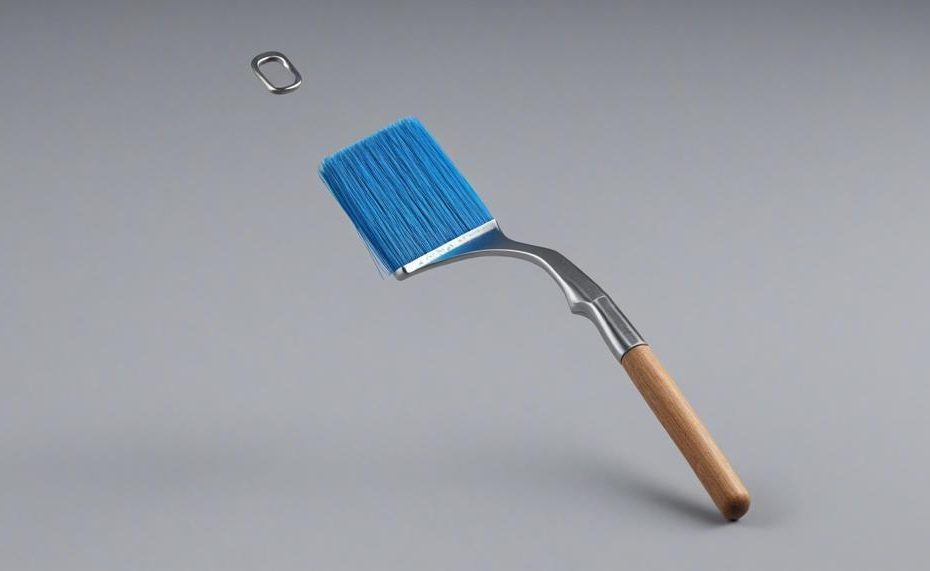You’ve found an old can of paint in the garage and you’re ready to give your space a fresh look without heading to the store. But how do you stir that old paint properly to ensure a smooth, even application? Here’s a straightforward guide to get you started.
How to stir old paint? It’s simple yet requires a bit of patience and the right tools. Follow these steps to revitalize your old paint:
- Gather Your Tools: Use a drill with a mixing attachment or a hand mixer. These tools will save you a lot of elbow grease.
- Mix Thoroughly: Stir the paint for at least 5-10 minutes. Consistency is key to avoid streaks and uneven color.
- Filter Out Lumps: Place a sock over the paint can and pour the paint into it to catch any clumps or dried bits.
- Use an Extended Mixing Attachment: If you’re using a drill, an extended attachment will make the job easier and more effective.
- Empty the Can Properly: Turn the old paint can upside down and let it empty into the sock-filtered bucket. This will help separate any remaining lumps.
Key takeaways:
- Patience is essential: Stir for the full 10 minutes.
- Proper tools make a difference: A drill or hand mixer ensures thorough mixing.
- Filtering: Using a sock to filter out lumps guarantees a smoother finish.
With these steps, you’ll transform that old, separated paint into a usable product, perfect for your next project. Remember, a little effort in preparation can save you a lot of hassle and produce a beautiful, even coat of paint.
Contents
How Long Does Paint Last?
The lifespan of paint depends on various factors, including type, storage conditions, and exposure to air. Here’s a detailed breakdown:
Factors Affecting Paint Lifespan
Type of Paint:
- Latex Paint: Unopened, it can last up to 10 years. Opened cans, if stored correctly, can last about 2 years.
- Oil-Based Paint: Unopened cans can remain usable for up to 15 years. Once opened, proper storage can extend its life to a couple of years.
- Chalk Paint: Typically lasts around 1 year, regardless of being opened or not.
- Milk Paint: Has a very short lifespan, lasting only about a week after being mixed.
Storage Conditions:
- Temperature: Optimal storage is between 60-80°F. Extreme temperatures can cause the paint to spoil quickly.
- Air Exposure: Paint exposed to air hardens and solidifies over time. Ensure cans are sealed tightly to minimize exposure.
- Impurities: Organic materials or contaminants can cause the paint to turn rancid, leading to an unpleasant odor and reduced quality.
Container Seal:
- Poorly sealed cans can result in paint that lasts only a few months.
- Always ensure lids are tightly closed and use additional sealing methods if necessary.
- Additives and Preservatives:
- Adding water to older latex paint can revive it to some extent. However, this should be done cautiously to avoid diluting the paint too much.
Lifespan Before Needing to be Stirred
Once paint is stored, it tends to separate, with heavier pigments settling at the bottom. Here’s how long you can expect different types of paint to last before they need stirring:
| Type of Paint | Unopened Lifespan | Opened Lifespan | Stirring Frequency |
|---|---|---|---|
| Latex Paint | Up to 10 years | 2 years | Every 2-3 months |
| Oil-Based Paint | Up to 15 years | 2 years | Every 2-3 months |
| Chalk Paint | 1 year | 1 year | Every month |
| Milk Paint | 1 week | 1 week | Before each use |
To stir old paint effectively, use a drill with a mixing attachment or a hand mixer for at least 5-10 minutes. For heavily solidified paint, filtering out lumps with a sock can help restore smoothness. Remember, patience is key when mixing old paint to ensure a consistent finish.
We Recommend
The best tools for stirring old paint effectively are an electric drill with a paint stirrer attachment and a handheld paint mixer. Let’s delve into the specifics:
Electric Drill with Paint Stirrer Attachment
Tool: Electric Drill
- Attachment: Paint Stirrer (spiral-shaped mixing blade)
- Advantages: Provides consistent and powerful mixing, breaking up clumps and thoroughly blending layers of paint.
- Usage: Attach the stirrer to the drill, insert into the paint can, and run the drill to mix the paint evenly.
- Advantages: Cost-effective, manually controlled mixing.
- Usage: Insert the paddle into the paint and stir manually, applying sufficient effort to mix thoroughly.
- Method: Use a scraping tool to break up clumps before stirring.
- Purpose: Facilitates smoother blending of the paint.
- Method: Add a small amount of water or paint thinner.
- Purpose: Helps to thin out the paint, making it easier to mix.
- Note: Check the paint type (oil-based or water-based) for the appropriate thinner.
- Method: Stir the paint and periodically check the consistency.
- Purpose: Ensures the paint is evenly mixed and ready for application.
- Read the Instructions: Always check the paint can for specific instructions related to that paint type.
- Consult Professionals: If in doubt, seek advice from a professional to ensure you are using the correct method and tools for your paint type.
- Expiration: Water-based paint lasts up to 10 years if unopened and stored correctly. Once opened, it should be used within two years.
- Texture and Consistency: If the paint has hardened or developed a chunky texture, it’s no longer usable.
- Odor: A sour or rancid smell indicates bacterial growth, which means the paint has gone bad.
- Separation: While some separation is normal, if the paint doesn’t blend smoothly after stirring, it’s time to dispose of it.
- Metal Can, Glass or Plastic: Use a lined metal can, glass, or plastic container for latex paints such as AURA®, REGAL®, and ben®. These materials prevent rust and ensure better preservation.
- Appropriate Size: Use a container that matches the amount of leftover paint to limit air exposure.
- Seal Tightly: Ensure the lid is sealed tightly to prevent air from entering. For additional security, place a piece of plastic wrap over the opening before sealing the lid.
- Store in a Dry Place: Keep the paint in a dry, temperate environment, away from direct sunlight, extreme temperatures, and moisture. Avoid storage places like garages or sheds that experience temperature fluctuations.
- Keep Out of Reach: Store paint out of reach of children and away from food storage areas to prevent accidental ingestion.
- Mark Containers: Label each container with the paint colour, type, and date of storage for easy identification and future reference.
Handheld Paint Mixer
Tool: Handheld Paint Mixer (paddle-shaped mixer)
Techniques for Effective Stirring:
Scraping:
Adding Thinners:
Consistency Check:

Practical Tips:
Tools and Techniques Table:
| Tool | Attachment | Advantages |
| Electric Drill | Paint Stirrer | Consistent, powerful mixing; breaks up clumps |
| Handheld Paint Mixer | Paddle-shaped mixer | Cost-effective; manual control |
| Scraping Tool | – | Facilitates smoother blending |
| Water/Paint Thinner | – | Thins out paint for easier mixing |
When to Toss It
Answer: It’s time to throw away old paint when it shows signs of spoilage, separation, or if it’s past its prime. Here are the key indicators:
Indicators for Tossing Paint
| Indicator | Description | Action |
| Expiration Date | Water-based paint lasts up to 10 years unopened, 2 years once opened. | Dispose of if beyond these periods. |
| Texture and Consistency | Hardened or chunky texture. | Throw away. |
| Odor | Sour or rancid smell. | Discard immediately. |
| Separation | Cannot blend smoothly after stirring. | Dispose of the paint. |
Test It Out
Testing the consistency and quality of old paint before stirring ensures you don’t waste time on spoiled paint. Here are some effective methods:
| Method | Description | Indicator of Quality |
| Inspect the Surface | Look for hardened layers or crust on the paint’s surface. | Hardened surface indicates spoiled paint. |
| Smell Test | Check for any foul or rancid odor. | Bad smell signifies spoilage. |
| Separation and Texture | Observe for unusual separation and stir to test texture. | Inability to blend smoothly suggests degradation. |
| Stirring Resistance | Gently stir and feel for any resistance or lumps. | Gritty or lumpy consistency indicates poor quality. |
| Shake the Container | Shake the paint container vigorously to mix contents. | Uneven mixing shows the paint is no longer good. |
Look at the Can
When examining a can of old paint before stirring it, here’s what to look for:
| Hardened Layers | Check the surface of the paint for any hardened layers or crust. If you find a thick, solid layer on top, the paint might be too old and unusable. | Tip: Use a stir stick to gently poke through the surface and assess the paint’s consistency. |
| Bad Smell | Open the can and take a whiff. A sour or rancid smell indicates that the paint has gone bad and should be discarded. | Note: Properly stored paint should smell like normal paint, not foul. |
| Unusual Separation | Look for unusual separation in the paint. Some separation is normal, but if it looks like cottage cheese or has large chunks, it’s no good. | Action: Stir well and observe if it blends smoothly. |
| Stirring Resistance | When you stir the paint, it should mix uniformly without too much resistance. Thick lumps or a gelatinous texture mean the paint has degraded. | Test: Stir with a paint stick and ensure it regains a smooth consistency. |
| Shaking the Container | Shake the paint can vigorously. If you hear solid lumps hitting the sides, the paint might be dried out inside. | Pro Tip: Shake and then open the can to check for smoothness. |
Ensuring your paint is still good can save you time and effort on your home improvement projects.
Strain It
The purpose of straining old paint is to remove impurities, ensuring a smooth, professional finish and enhancing the paint’s adherence to surfaces. This step, often overlooked by amateurs, is vital for a durable paint job.
Straining eliminates debris, dried flakes, and other contaminants that can mar the final appearance and compromise adhesion.
Effective Straining Techniques
Preparation and Tools: Gather a clean container, mesh strainer or pantyhose, and a stirring stick. Stirring the paint beforehand helps evenly distribute particles and prevents the filter from clogging.
Choosing the Right Filter
Latex Paints: Use a fine mesh strainer.
Oil-Based Paints: Use an even finer filter.
Finer Straining: Employ cheesecloth, layering it over the container.
Straining Process
Place the strainer over a clean container.
Pour the paint through the filter, allowing impurities to be caught.
Gently stir the paint to ensure an even flow and prevent clogging.
Post-Straining Cleanup
Immediately clean all tools to prevent blockages and ensure consistent finishes in future projects.
Opened Cans
The best way to store and preserve opened cans of paint to keep them usable for future projects involves several key steps:
Choose the Right Container
Sealing and Environment
Labeling
Conclusion
Revitalizing old paint isn’t just a task—it’s an art that breathes new life into your walls and saves you a trip to the store. To stir old paint effectively, patience and the right tools are your best allies. Begin by gathering a drill with a mixing attachment or a hand mixer, tools that significantly ease the process. Stirring thoroughly for 5-10 minutes ensures a consistent texture, crucial for a smooth application.
Filtering is another essential step. Use a sock to strain the paint, removing any clumps or dried bits that could ruin your finish. An extended mixing attachment on your drill can make reaching the bottom of the can easier, ensuring even the most settled pigments are mixed in.
Proper storage and timely stirring can extend the life of your paint. Latex paint, for example, can last up to 10 years unopened and two years once opened if stored correctly. Regularly stirring stored paint every few months can prevent it from separating too much, making your next painting project much easier.
In essence, the key to successfully stirring old paint lies in thorough preparation and mixing.





